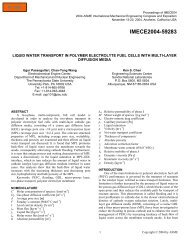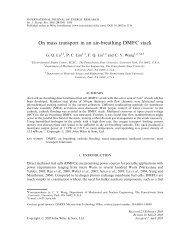4486 Journal <strong>of</strong> The Electrochemical Society, 147 (12) 4485-4493 (2000)S0013-4651(00)08-104-0 CCC: $7.00 © The Electrochemical Society, Inc.Figure 1. Schematic diagram <strong>of</strong> a proton exchange membrane fuel cell(PEMFC).oxidation and oxygen reduction reactions are considered to occuronly within the active catalyst layers where Pt/C catalysts are intermixeduniformly with recast ionomer. Other aspects <strong>of</strong> hydrogen fuelcell modeling can be found in the works <strong>of</strong> Bernardi and Verbrugge 6and Springer et al. 8The fuel and oxidant flow rates can be described by a stoichiometricflow ratio, , defined as the amount <strong>of</strong> reactant in the chambergas feed divided by the amount required by the electrochemicalreaction. That is0 0 p[1] 4F XO 2RT IA0 0 p[2] 2F XH 2RT IAwhere 0 is the inlet volumetric flow rate to a gas channel, p and Tthe pressure and temperature, R and F the universal gas constant andFaraday’s constant, I the current density, and A the electrode surfacearea. The subscripts () and () denote the cathode and anodesides, respectively. For convenience, the stoichiometric flow ratiosdefined in Eq. 1 and 2 are based on the reference current density <strong>of</strong>1 A/cm 2 here so that the ratios can also be considered as dimensionlessflow rates <strong>of</strong> the fuel and oxidant.Model assumptions.—This model assumes (i) ideal gas mixtures;(ii) incompressible and laminar flow due to small pressure gradientsand flow velocities; (iii) isotropic and homogeneous electrodes, catalystlayers, and membrane; (iv) constant cell temperature; and (v)negligible ohmic potential drop in the electronically conductive solidmatrix <strong>of</strong> porous electrodes and catalyst layers as well as the currentcollectors.Governing equations.—In contrast to the approach <strong>of</strong> Gurauet al., 11 which employs separate differential equations for differentsubregions, we take the single-domain approach used in our previousbattery models in which a single set <strong>of</strong> governing equations validfor all subregions is used. As a result, no interfacial conditions arerequired to be specified at internal boundaries between various regions.Generally, fuel cell operation under isothermal conditions isdescribed by mass, momentum, species, and charge conservationprinciples. Thus, under the above-mentioned assumptions, the modelequations can be written, in vector form, as 19∂( ) ( u) 0[3]∂t∂( u)eff ( uu) p ( u) Su∂t[4]∂( Xk) ( uX [5]k ) ( Dk eff Xk ) Sk∂t( eff e e ) S 0 [6]Here, u, p, X k , and e denote the intrinsic fluid velocity vector,pressure, mole fraction <strong>of</strong> chemical species k, and the phase potential<strong>of</strong> the electrolyte membrane, respectively. The diffusion coefficient<strong>of</strong> species k and ionic conductivity <strong>of</strong> the membrane phase inEq. 5 and 6 are effective values modified via Bruggman correlationto account for the effects <strong>of</strong> porosity and tortuosity in porous electrodes,catalyst layers, and the membrane. That isD eff k 1.5 m D k [7] eff k 1.5 m k [8]where m is the volume fraction <strong>of</strong> the membrane phase. Other symbolsin Eq. 3 through 8 can be found in the List <strong>of</strong> Symbols.It is worth further explaining the mole fraction <strong>of</strong> oxygen appearingin Eq. 5 because oxygen is a gaseous species in the cathodeflow channel and gas-diffusion electrode but becomes a species dissolvedin the electrolyte in the catalyst layer and membrane regions.Our definition is given by⎧ g⎪ck/ ctotin the gas phaseXk ⎨[9]⎩⎪ ck e / ctotin the electrolytewhere c k is the molar concentration <strong>of</strong> species k and superscripts gand e denote the gas and the electrolyte phases, respectively. Thus,X k is a true mole fraction in the gas phase but is a pseudo mole fractionwhen species k is in the dissolved form. In addition, there is adiscontinuity in the value <strong>of</strong> X k at the interface between the gas-diffusionelectrode and the catalyst layer due to the following thermodynamicrelationRTc[10]k e,satH c gH c g k ′ kwhere H is the Henry’s law constant equal to 2 10 5 atm cm 3 /molfor oxygen in the membrane. 5 The dimensionless Henry’s constant,H, is thus approximately equal to 0.15 at 80C.In spite <strong>of</strong> the discontinuity in X k across the interface between thecatalyst layer and gas-diffusion electrode, the single-domain formulation,Eq. 5, intrinsically maintains the balance <strong>of</strong> species fluxes;namelyXX( Dk eff ∂) k ( Dk eff ∂) k[11]∂n∂nwhere the symbols () and () stand for the left and right sides <strong>of</strong>the interface. Substituting the definition <strong>of</strong> X k given in Eq. 9 intoEq. 11 yields the following interfacial balance <strong>of</strong> species fluxesccDe eff ke Dg eff g∂∂ k [12]∂n∂nNotice also that three source terms, S u , S k , and S , appear inmomentum, species, and charge conservation equations to representvarious volumetric sources or sinks arising from each subregion <strong>of</strong> afuel cell. Detailed expressions <strong>of</strong> these source terms are given inTable I. Specifically, the momentum source term is used to describeDarcy’s drag for flow through porous electrodes, active catalyst layers,and the membrane. 6,11,16 If there is very small hydraulic permeability(e.g., 10 14 cm 2 ) in the membrane region, the pore velocitybecomes so small that the inertia and viscous terms in Eq. 4 drop <strong>of</strong>f,and the momentum equation reduces to the well-known Darcy’s lawas used by Bernardi and Verbrugge. 6 In addition, electro-osmotic dragarising from the catalyst layers and the membrane is also included.Either generation or consumption <strong>of</strong> chemical species k and thecreation <strong>of</strong> electric current (see Table I) occurs only in the active cat-
Journal <strong>of</strong> The Electrochemical Society, 147 (12) 4485-4493 (2000) 4487S0013-4651(00)08-104-0 CCC: $7.00 © The Electrochemical Society, Inc.Table I. Source terms for momentum, species, and charge conservation equations in various regions.S u S k S Gas channels 0 0 N/ABacking layers uK0 0j a2Fctotafor H 2Catalyst Layers k m mcu kkz f c f F eppjc4Fctotcfor O 2jj c2Fctotcfor H O 2 kMembrane mu 0 0k kz f c f F eppalyst layers where electrochemical reactions take place. The S k andS terms are therefore related to the transfer current between thesolid matrix and the membrane phase inside each <strong>of</strong> the catalyst layers.These transfer currents at anode and cathode can be expressed asfollows 4 1/2⎛ X ref H⎞2 ⎛ a c⎞ja aj0,a⎜ ⎟ ⎜ F ⎟[13]⎝ XH, ref ⎠ ⎝ RT ⎠2⎛ X ref O⎞2 ⎛ cF⎞jc aj0,c⎜ ⎟ exp⎜ ⎟[14]⎝ XORT2 , ref ⎠ ⎝ ⎠The above kinetics expressions are derived from the general Butler-Volmer equation based on the facts that the anode exhibits fast electrokineticsand hence a low surface overpotential to justify a linearkinetic rate equation, and that the cathode has relatively slow kineticsto be adequately described by the Tafel equation. In Eq. 13 and14, the surface overpotential, (x, y), is defined as(x, y) s e V oc [15]where s and e stand for the potentials <strong>of</strong> the electronically conductivesolid matrix and electrolyte, respectively, at the electrode/electrolyteinterface. V oc is the reference open-circuit potential<strong>of</strong> an electrode. It is equal to zero on the anode but is a function <strong>of</strong>temperature on the cathode, 24 namelyV oc, 0.0025T 0.2329 [16]where T is in kelvin and V oc is in volts. Notice that V oc is not the trueopen-circuit potential <strong>of</strong> an electrode, which would then dependupon reactant concentrations according to the Nernst equation. Instead,V oc is only the constant part <strong>of</strong> the open-circuit potential. Itsconcentration-dependent part in logarithmic form can then be movedout <strong>of</strong> the exponent in the Butler-Volmer equation and now becomesthe concentration terms in front <strong>of</strong> the exponent in Eq. 13 and 14, respectively.Equation 13, which is a rewritten form <strong>of</strong> the Nernstequation, precisely describes the effect <strong>of</strong> decreasing transfer currentunder hydrogen dilution. Based on the experimental data <strong>of</strong> Parthasarathyet al., 24 the dependence <strong>of</strong> the cathodic exchange currentdensity on temperature can be fitted asi0( T)T[17]i0 353 exp[ 0. 014189 ( 353)]( K) Under the assumption <strong>of</strong> a perfectly conductive solid matrix forelectrodes and catalyst layers, s is equal to zero on the anode sideat the anodic current collector and to the cell voltage on the cathodeside at the cathodic current collector. Thus, the surface overpotentialgiven by Eq. 15 is only dependent on the membrane phase potential,which is to be solved from Eq. 6.The species diffusivity, D k , varies in different subregions <strong>of</strong> thePEMFC depending on the specific physical phase <strong>of</strong> component k.In flow channels and porous electrodes, species k exists in thegaseous phase, and thus the diffusion coefficient takes the value ingas, whereas species k is dissolved in the membrane phase within thecatalyst layers and the membrane, and thus takes the value correspondingto dissolved species, which is usually a few orders <strong>of</strong> magnitudelower than that in gas (see Table II). In addition, the diffusioncoefficient is a function <strong>of</strong> temperature and pressure, 25 i.e.D T D T 3/2⎛ ⎞ ⎛ po⎞( ) 0 ⎜[18]T⎟ ⎜ ⎟⎝ o ⎠ ⎝ p ⎠The proton conductivity in the membrane phase has been correlatedby Springer et al. 7 ase ( T)exp ⎡ 100 1268⎛ 1 1⎞ ⎤⎢( 0 . 005139 0303 T. 00326⎣ ⎝ ⎠ ⎥⎦)in S/cm [19]where the water content in the membrane, , depends on the wateractivity, a, according to the following fit <strong>of</strong> the experimental data⎧2 3⎪0. 043 17. 18a 39. 85a 36.0a for 0 < a 1 ⎨[20]⎩⎪ 14 1. 4( a 1)for 1 a 3The water activity is in turn calculated byX pa H 2 Osat[21]pwhere the saturation pressure <strong>of</strong> water vapor can be computed fromSpringer et al. 7log 10 p sat 2.1794 0.02953 (T 273.15) 9.1837 10 5 (T 273.15) 2 1.4454 10 7 (T 273.15) 3 [22]The above calculated saturation pressure is in bars. Apparently, thewater mole fraction X H2 O , water activity, and water content all varyspatially in the membrane layer, and thus the membrane conductivity e is a variable.For this multicomponent system, the general species transportequation given in Eq. 5 is applied to solve for mole fractions <strong>of</strong>




